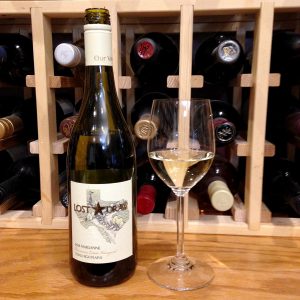Pale straw color; apricot, mandarin orange, vanilla on the nose; mandarin orange, green apple, apricot, white peach, quince, beeswax on the palate.

Dry; rich and fruity with illusion of sweetness. Medium body with excellent texture in the mouth. Very moderate acidity; no tannin. Fermented in stainless with no subsequent exposure to oak. The quince tartness presents on the mid-palate and finish, which may cause pause to some, but that fades with exposure to air. There is a silky, slightly oily texture which is a marsanne feature, not a flaw, typically described as beeswax. Marsanne and this effort stretches your appreciation of the dimensions of wine.
Marsanne tends to fall between Chablis-style chardonnay and viognier, and is a worthy alternative to both, especially for pairing with food. The grape, and this wine, are not warm puppy delicious and require some vino sophistication. Marsanne is the most-planted white wine grape in the Northern Rhône, where it usually blends with roussanne (which likely is its parent) and clairette. Marsanne brings depth and rich textures to the Rhône blends, and those elements clearly present in this Texas High Plains AVA varietal rendition.
Lost Draw Cellars is the Texas wine industry in a nutshell. Andy Timmons is a multi-generation farmer on the Texas High Plains—the vast flatlands very roughly between Lubbock and Amarillo and New Mexico. Timmons was a pioneer grape grower, a follow-on to his family career growing cotton and peanuts. Grapes are a high risk, high reward crop. No agricultural product produces more income when everything works. Like almost all agricultural products, there is no reward when things—hail, late frost, tornadoes on the High Plains—go wrong. Timmons rolled the dice and today he owns and manages 500 acres producing 30 varieties, one of the largest wine grape operations in Texas.
Andrew Sides, nephew to Andy Timmons, was an engineering student at Texas Tech University in Lubbock when he helped Uncle Andy plant his first vine crop in 2006 on a five-acre piece of the home place now called Lost Draw Vineyards. The family experimented with what would work on the High Plains—every Texas grape dreamer was doing this; the Old World had a two-plus millennium head start. Texans aren’t dumb, however, and they looked to see what worked in France, Spain, and Italy in climates, soils, and elevations similar to the High Plains and Texas. Marsanne was one of the grapes.
In 2010, Andrew Sides married his college sweetheart, Callie Ottmers. Callie’s father, Troy Ottmers, is a bedrock citizen in Fredericksburg who traces his family roots back to the town’s founding by German settlers in 1846. Ottmer Oil was a Fredericksburg institution from the 1930s into the early 21st century. Its industrial-like setting is sandwiched between a Shell station and a Chevron oil products depot, and across from the backside of the HEB grocery store—Texans will easily understand this triangulation.
This is Texas, and uncle, nephew, and father-in-law saw Ottmer Oil as an ideal place to have a Hill Country AVA winery that produces wines using grapes grown on the Texas High Plains AVA. That is the Texas formula—grow grapes around Lubbock in the eight-million-acre Texas High Plains AVA, then make wine or at least have a tasting room, in the nine-million-acre, high traffic Texas Hill Country AVA between San Antonio and Austin. Hey, it works. The Hill Country AVA is the second-most visited AVA in the United States, second only to over-crowded Napa.
Like many Texas wines, you are not likely to find this in a local wine store. Sales come from their tasting room, 113 E. Park St. in Fredericksburg—well worth a visit. Tell manager Chris Herrera I sent you. They also sell through their wine club and via the internet. Lost Draw can ship to 43 states, so it is worth a shot. Lost Draw also sells two non-vintage blends in grocery stores (mainly HEB): Lost Draw Arroyo Blanco and Lost Draw Arroyo Rojo. As grocery store wines go, these are worth a try.
Lost Draw Cellars Marsanne, Timmons Estate Vineyard, Texas High Plains 2018 is a correct iteration of marsanne with a Texas twist. If you want to move beyond chardonnay, visit marsanne. Marsanne is a wine that you think “what?” on the first sip or two, but by second glass you get it. Especially paired with food, which is where marsanne really shines. Marsanne’s classic pairing is with rich shellfish—shrimp in particular, but any shellfish or seafood will do. Also chicken, veal, pork, spicy Asian cuisine—Thai and Vietnamese in particular. Works with cream sauce dishes and many cheeses, both hard and soft. $26-27
Visit the website for photos.
